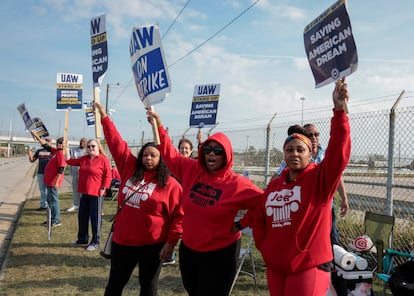US auto strike takes aim at executives’ multimillion-dollar salaries
The CEOs of the automakers earn between 281 and 365 times what an average employee makes in a year


An average Stellantis worker would have to work 365 years to make as much as what Carlos Tavares, the company’s CEO, earned in 2022. General Motors (GM) boss Mary Barra earns 362 times more than an average employee. And in the case of Ford, its chief made 281 times more than the median worker — i.e. the employee with as many people above them as below. In the strike against the three Detroit giants, the leader of the United Auto Workers (UAW) union, Shawn Fain, is using the companies’ huge profits and their CEOs’ stratospheric salaries to inflame workers’ anger. He argues that the pay rise that the union is demanding is not disproportionate in view of these multimillion-dollar pay packages.
U.S. President Joe Biden agreed with the workers on Friday: “Over the past decade auto companies have seen record profits, including over the last few years because of the extraordinary skill and sacrifice of the UAW workers,” Biden said from the White House. “Those record profits have not been shared fairly, in my view, with those workers.”
In the last three years, GM has achieved profits of $26.38 billion. In July, the company raised its earnings forecasts for this year to between $9.3 billion and $10.7 billion. Its president and CEO, Mary Barra, earned $23.7 million in 2020; $29.1 million in 2021, and $29 million last year. The group has 104,000 employees in the United States and 63,000 in other countries. The average employee (calculated according to the rules of the United States Securities and Exchange Commission, which allows workers from countries with little weight in the total to be excluded) received $80,000. In other words, Barra earned 362 times more than the workers, according to the company’s official information.
Ford has also raised its forecasts for this year: it expects to make between $11 billion and $12 billion, in this case in net operating income. The company recorded losses in 2022 due to the loss in value of its electric vehicle subsidiary Rivian and the closure of Argo, its investment in self-driving cars with Volkswagen. Even so, it has made $14.68 billion in three years. Its president and CEO, James Farley, earned $11.8 million in 2020; $22.8 million in 2021 and $21.0 million in 2022. Ford had 186,769 employees in 2022, of which 90,873 were in the United States. Farley’s pay package was 281 times that of the median employee, about $74,700 a year.

Stellantis has made $33.17 billion in profit in the last three years. Its CEO Carlos Tavares earned €19.2 million ($20.5 million) in 2021 and €23.5 million ($25.1 million) in 2022. According to the company’s own calculations, this last figure is 365 times the average employee salary (€64,328, $68,696) of this group, which is based in the Netherlands and follows a slightly different calculation criteria than that of GM and Ford. Stellantis shareholders voted against Tavares’ compensation package, but that vote was only advisory: it was not binding.
The CEOs have defended their salaries, claiming that a large part of their remuneration package is variable and in shares. In other words, it is linked to the company’s results and its value on the stock market. That, however, can be problematic. Containing costs (including salaries) allows companies to earn more. This in turn leads to higher stock market price and juicer bonuses for CEOs: it’s a recipe for conflict.
The UAW initially demanded a 40% wage increase over four years, but have reduced their demands to 36%. But according to their accounts, CEO salaries did rise by 40% in the past four years — the period of the last collective agreement — while they only saw a 6% increase, despite high inflation. Although this figure depends on the methodology used, it is clear that the salary gap between what top executives and workers earn has been widening in recent decades, and not only in the automobile sector.
“The reason we ask for 40% pay increases is because in the last four years alone, the CEO pay went up 40%. They’re already millionaires,” Fain told CBS. “Our demands are just. We’re asking for our fair share in this economy and the fruits of our labor.”
The UAW union and the automakers have resumed negotiations. Meanwhile, the strike continues at three plants (one at each of the companies) in three different states (Michigan, Missouri and Ohio). The union has opted for a selective strike, although it is considering the possibility of expanding the industrial action.
The strike’s impact on businesses and the economy more broadly is not yet clear. “It’s premature to be making forecasts about what it means for the economy,” said Treasury Secretary Janet Yellen in an interview on CNBC on Monday. “It would depend on how long the strike lasts and who would be affected by it.” Yellen believes that “the two sides need to narrow their disagreements and work for a win-win.”
Tesla and Toyota, winners of the strike
The strike against the three Detroit giants has only just begun, but it already has several winners. General Motors, Ford and Stellantis, with their workers affiliated with the UAW union, have been forced to stop production and increase labor costs, which are already much higher than those of Tesla, for example. Elon Musk's company, which is more productive in the manufacture of electric cars, will be able to protect its margins against its large American competitors. Tesla workers receive part of their pay in shares, but are not unionized.
The other winners are foreign manufacturers, especially those with greater penetration in the U.S. market, such as Toyota, Hyundai, Honda and Nissan. Some have assembly plants in the United States, but their workforces are also not affiliated with the UAW and are not affected by the strike.
Sign up for our weekly newsletter to get more English-language news coverage from EL PAÍS USA Edition
Tu suscripción se está usando en otro dispositivo
¿Quieres añadir otro usuario a tu suscripción?
Si continúas leyendo en este dispositivo, no se podrá leer en el otro.
FlechaTu suscripción se está usando en otro dispositivo y solo puedes acceder a EL PAÍS desde un dispositivo a la vez.
Si quieres compartir tu cuenta, cambia tu suscripción a la modalidad Premium, así podrás añadir otro usuario. Cada uno accederá con su propia cuenta de email, lo que os permitirá personalizar vuestra experiencia en EL PAÍS.
¿Tienes una suscripción de empresa? Accede aquí para contratar más cuentas.
En el caso de no saber quién está usando tu cuenta, te recomendamos cambiar tu contraseña aquí.
Si decides continuar compartiendo tu cuenta, este mensaje se mostrará en tu dispositivo y en el de la otra persona que está usando tu cuenta de forma indefinida, afectando a tu experiencia de lectura. Puedes consultar aquí los términos y condiciones de la suscripción digital.
More information
Archived In
Últimas noticias
Most viewed
- Reinhard Genzel, Nobel laureate in physics: ‘One-minute videos will never give you the truth’
- Oona Chaplin: ‘I told James Cameron that I was living in a treehouse and starting a permaculture project with a friend’
- Pablo Escobar’s hippos: A serious environmental problem, 40 years on
- Why we lost the habit of sleeping in two segments and how that changed our sense of time
- Chevy Chase, the beloved comedian who was a monster off camera: ‘Not everyone hated him, just the people who’ve worked with him’










































